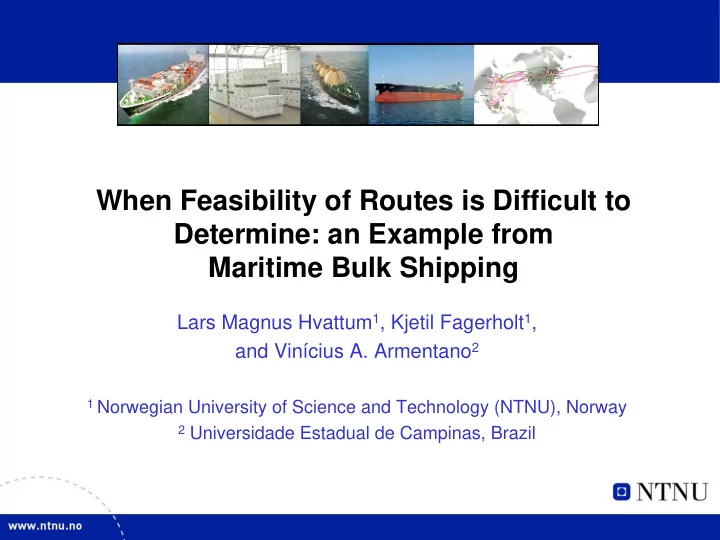

When Feasibility of Routes is Difficult to Determine: an Example from Maritime Bulk Shipping Lars Magnus Hvattum 1 , Kjetil Fagerholt 1 , and Vinícius A. Armentano 2 1 Norwegian University of Science and Technology (NTNU), Norway 2 Universidade Estadual de Campinas, Brazil
Main Problem 3- 3- 1+ 1+ 4+ 4+ 2+ 2+ 1- 1- 3+ 3+ 4- 4- 5- 5- 5+ 5+ 2- 2-
Vessel Routes 3- 3- 1+ 1+ 4+ 4+ 2+ 2+ 1- 1- 3+ 3+ 4- 4- 5- 5- 5+ 5+ 2- 2-
Possible Solution 1+ 2+ 2- 1- 1+ 2+ 2- 1- 3+ 3- 3+ 3- 4+ 4- 5+ 5- 4+ 4- 5+ 5-
Constraints (1) • Each cargo must be allocated to one or several tanks • Cargo quantity must not exceed the total capacity of these tanks – Volume – Weight
Constraints (2) • Tanks have different coatings, and cargos can only be allocated to tanks with compatible coatings +1 +1 +1 +1
Constraints (3) • It is not allowed to move a cargo between tanks after it has been loaded • It is not allowed to mix cargos, even if it is the same product, in the same tank • At the beginning of the planning horizon, some tanks may be already occupied by some cargos that have not yet been unloaded • It may be prohibited to have tanks that are only half-full, in order to avoid sloshing cargos
Constraints (4) • There are requirements with respect to the stability (A, B) and strength (C) of the ship A) B) C) - + + - + + - -
Constraints (5) • Due to hazmat rules, certain products cannot be allocated to neighboring tanks • Due to hazmat rules, certain products cannot be onboard the same vessel at the same time • Due to hazmat rules, certain products cannot be allocated in sequence to the same tank, except if the tank has been cleaned or the tank has been used by a number of other cargos in between
Model for the Single Instant TAP
Model for the Tank Allocation Problem
Objective functions • Minimize the number of cleaned tanks • Maximize capacity of vacant tanks during the vessel route? – increasing flexibility for future changes in the route • Maximize the probability of being able to accept future transportation requests? – must take all vessel routes into consideration • Anyway, feasibility is more important!
Computational Complexity • Finding a feasible solution is NP-complete – even when considering a single instant of the vessel route • i.e., can a given set of cargos be present on the ship simultaneously, disregarding the sequence of loading/unloading? – even if disregarding • all hazmat regulations • all stability/strength restrictions • anti-sloshing constraints – even if allowing loads to be mixed in tanks • proofs of NP-completeness then use either hazmat constraints or stability/strength constraints
Test Instances • First, how much time is required to solve realistically sized instances? • Instances generated by varying – Ship configuration (24 tanks or 38 tanks) – Number of loads (10, 20, or 30) – Load categories (0%, 10%, 20%, or 30% of loads are hazardous) – Min/max levels of ship utilization (65%, 75%, or 85% full) – Size of loads (1-5, 3-9, or 8-16 thousand tons) • All instances include a history of 10 loads (some of which may still be present on the ship) • Stability w.r.t. roll is enforced
Results using CPLEX • Two different objective functions – obj1: minimize the number of tank cleanings • potential problem: little guidance when branching – obj2: maximize average free capacity during the voyage
Which Dimensions Matter? more loads = more difficult more loads = more difficult more hazmat = more difficult more hazmat = more difficult higher ship utilization = unclear higher ship utilization = unclear smaller loads = more difficult smaller loads = more difficult more tanks = more difficult more tanks = more difficult
Solving TAPs and Future Work • Most realistically sized instances solved by CPLEX within 1 second – OK if the goal is to find a feasible stowage plan • Some instances cannot be solved within 10 minutes – CPLEX is not robust • We can try to modify branching priorities to see if this can guide CPLEX in the difficult cases? • We can try Constraint Programming solvers? • We can develop special heuristics that might be better suited to find feasible solutions?
1) Finding Stowage for a Route 3- 3- 1+ 1+ 4+ 4+ 2+ 2+ 1- 1- 3+ 3+ 4- 4- 5- 5- 5+ 5+ 2- 2-
2) Finding Routes and Stowage Together? 3- 3- 1+ 1+ 4+ 4+ 2+ 2+ 1- 1- 3+ 3+ 4- 4- 5- 5- 5+ 5+ 2- 2-
Solving the Main Problem • For now we focus on the subproblem, TAP • Eventually, the goal is to solve the main problem: finding the best vessel routes with a feasible stowage plan • We know that metaheuristic search, such as Tabu Search, works well for routing problems – Efficient neighborhood exploration • What is the best strategy when evaluating a neighbor is NP-complete?
Future Research • Improved neighborhood exploration – First Improvement – Neighborhood reductions • Granular Tabu Search – Surrogate Evaluation • Delay evaluation of stowage plan • How to handle infeasible stowage problems? • Improved solution methods for the stowage problem – Use the stowage plan of current solution as a starting point for finding a stowage plan when evaluating a neighboring solution • Other?
When Feasibility of Routes is Difficult to Determine: an Example from Maritime Bulk Shipping Lars Magnus Hvattum 1 , Kjetil Fagerholt 1 , and Vinícius A. Armentano 2 1 Norwegian University of Science and Technology (NTNU), Norway 2 Universidade Estadual de Campinas, Brazil
Recommend
More recommend